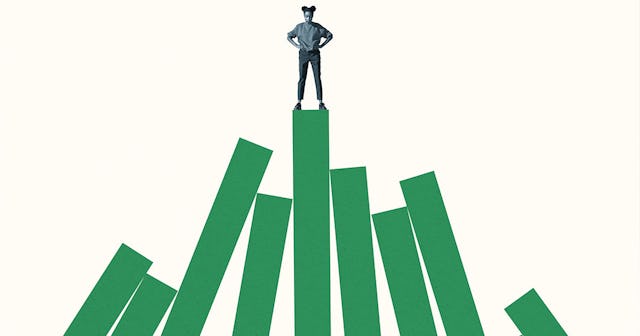Americans Are Not Very Resilient, And It's Affecting Our Health

Resilience is a word that’s thrown around casually. Most times that I’ve heard it, it’s used with respect to children undergoing a traumatic or difficult experience, like loss or living in the pandemic. Well-intentioned folks might click their tongue and shake their heads at the circumstances and then try to buoy everyone’s spirits by repeating the platitude: “children are so resilient.”
But what is resilience exactly? Are children truly resilient? Are adults? What does it mean to be resilient? And…what if you aren’t resilient? Can you become resilient, or is your invisible “resilience meter” set for life?
In August 2020, Cigna surveyed 5,000 children ages 5-17 and their parents, 1,500 young adults ages 18-23 and 5,000 U.S. working-aged adults as part of its Cigna Resilience Index to better understand resilience. The results were eye opening, if not a touch discouraging. The study found that 60% of Americans do not have high resilience, but there’s room for change.
Scary Mommy spoke to Dr. Stuart Lustig, national medical executive for Behavioral Health at Cigna and a board-certified child psychiatrist, about the results of this survey and what that 60% number means—and what can be done to help folks become more resilient.
What Is Resilience And Why Do We Need It?
Resilience is the kind of word we hear and understand, maybe even use, but if we stopped to define it, we might struggle. Merriam-Webster defines resilience as “an ability to recover from or adjust easily to misfortune or change.” Cigna writes that “resilience is your ability to use your personal skills and the resources around you to overcome the challenges you’re up against,” when faced with adversity. The way I understand it, resilience means the ability to stand up after being knocked down by life, to bounce back after a disaster—whether a global or personal one.
Lower resilience is associated with worse physical and mental health, higher stress and anxiety levels, lower feelings of self-worth and self-esteem, and lower academic aspirations and achievement. When resilience is low, particularly in children, they may not feel good about their prospects, they may feel less optimistic that education or training will be useful, or feel less like they’ll be able to achieve in life. That could add up to missed opportunities, to life-changing experiences avoided, to dreams going unfollowed.
What Age Groups Are Most Resilient?
fizkes/Getty
According to Dr. Lustig, we are “all born with certain amount of innate resilience, and then life happens.”
The results of the survey support that conclusion and found a resilience curve shaped like a “U.” Resilience starts high. Children ages 5-10 are the most resilient of all the age groups, with 45% of responding children scoring high in resilience. From there, resilience drops as kids enter adolescence, until it reaches its lowest point for those aging in range from 18-23. Just 22% of young adults who responded to the survey were found to be highly resilient. The curve creeps back up for parents, with 42% of parents scoring high in resilience.
Why Does Resilience Drop?
One of the biggest drivers of resilience is connection, according to Dr. Lustig. As kids enter adolescence many (most, even) kids begin to question who they are and who their friends are. They are trying to figure out who they want to be. As a result, connections to coaches, mentors, friends, parents may become tenuous. Likewise, kids ages 18-23 are just beginning to leave home in many cases, and losing friends and relationships that had once been a part of a daily life. That loss of connection may lead to the drop in resilience.
How Does The Pandemic Affect Resilience?
According to Dr. Lustig, it’s too early to tell how the pandemic will affect resilience.
What we know is that, for many of us, the pandemic has made our usual sources of connection difficult to access. For children, they may have lost access to counselors, teachers, or coaches, due to virtual school and canceled sports and extracurricular activities. The majority of children, 54%, are feeling distressed or anxious about COVID and anxiety is associated with less resilience.
Can Resilience Be Built Up?
The good news is resilience can be built up. The survey found that community engagement, exposure to diversity, and social connection are the keys to building resilience.
Cigna developed the G.R.O.W. campaign to help people learn the tools they need to navigate the world.
- G: Ground yourself in the situation. Write down your dream outcome. For children, this could mean helping them think of what the ideal final result would be.
- R: Recognize what you can control. Dr. Lustig suggests this is important because having a locus of control reduces stress levels. Interestingly, the survey found that those who create social media content are more resilient than those who passively consume, and one potential explanation is related to control. If you create content, you’re in control of what’s out out there.
- O: Organizing the resources that you need. Seek out help.
- W: Work with your community for support and recognize that seeking help is a sign of strength. Exposure to people with different racial and socioeconomic backgrounds drives resilience up, as does feeling like you belong.
We don’t yet know what affect the pandemic will have on resilience. Even before the pandemic, 60% of Americans did not have high resilience. That number may seem meaningless on paper, but it has real life, often negative, consequences.
But it’s important to remember that low resilience is not permanent, and it can and should be built up for kids and adults, even in a pandemic, even in 2020. Because simply repeating “children are resilient” isn’t enough, and we can do better.
To learn how resilient you are, check out the questionnaire here: https://cignaresilience.com/questionnaire/
This article was originally published on